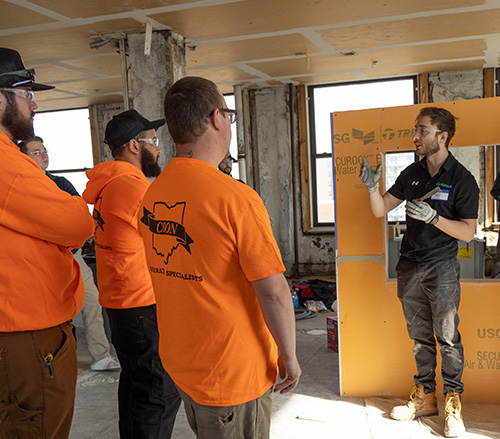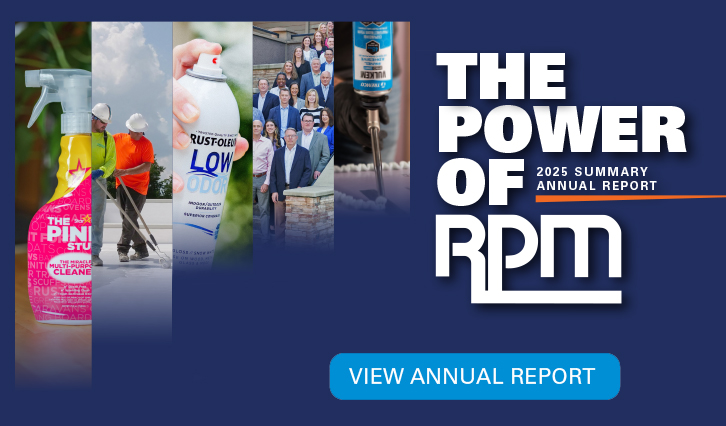
To fulfill our environmental commitments, we have established a robust environmental management system (EMS) that is ingrained in all our activities. This system prioritizes environmental, health and safety (EHS) initiatives throughout our operations.
Our EMS program is overseen at the corporate level by RPM’s Vice President – Environmental, Health & Safety. This role reports directly to the Vice President - Operations, who reports to the Chief Executive Officer and provides updates on operations to the Board of Directors.
Our environmental management efforts are guided by MS (Manufacturing System)-168, a center-led approach to operational oversight that applies lean manufacturing principles to improve our processes. This approach has supported MAP (Margin Achievement Plan) 2025, RPM’s companywide initiative to increase operational efficiencies. Together, these programs drive reductions in waste, emissions and use of water and energy.
Many of our facilities also pursue third-party certifications, such as the International Organization for Standardization (ISO) certification for environmental management.
To further drive improvement initiatives, we offer Six Sigma Green Belt Training to facility leaders, who serve as internal resources for operational efficiency. More than 500 associates have completed Six Sigma Green Belt training, and since 2020, our Green Belt projects have resulted in approximately $43 million in operational savings. These projects are examples of how resource efficiency can lead to sustainable operations and cost optimization.

HIGHLIGHT
- Reduce waste at its source by improving process efficiency
- Reclaim and recover materials that would have gone to waste
- Recycle waste outputs where possible and transition to recyclable product packaging and storage solutions
- Reuse materials and equipment until the end of their life cycle


Associates at Rust-Oleum’s Hagerstown, Maryland, plant identified inconsistent batch yields, which were impacting cost and paint waste. Through equipment inspections, audits and process mapping, the team implemented engineering and operational improvements to reduce paint waste and hazardous waste while boosting batch yield quality. These efforts delivered nearly $1 million in cost savings annually with increased efficiency.
Viapol’s Caçapava facility in Brazil struggled with high electricity costs from compressed air leaks, overuse of exhaust blowers and penalties for demand overages. To help lower costs, the team introduced ultrasonic leak detection and automated compressor controls and renegotiated their energy contracts. These changes improved energy measurement accuracy, reduced unnecessary consumption and optimized plant infrastructure, achieving an estimated annual savings of more than $200,000 and an estimated CO<sub>2<sub/> reduction of 29 tons annually.
Our EMS is used to develop and implement effective and sustainable environmental management programs across our organization, enabling us to:
Our EMS is used to develop and implement effective and sustainable environmental management programs across our organization, enabling us to:
Through our annual EHS audit program, a component of our center-led EHS management program, we review the content and effectiveness of our protocols. This program consists of audits for:
- Targeted environmental compliance
- Health and safety compliance
- Property risk/fire protection
- Product stewardship & chemical compliance
Our EHS management team conducts risk assessments to help prioritize our audits, which are completed by a qualified, third-party firm. The audits are used to determine actionable steps to improve our EHS performance and serve as a resource for local managers to enable compliance with standards set forth by governing agencies, RPM and industry best practices. Our goal is to identify ways we can further improve our health and safety outcomes.
Our investment in a web-based Data Navigator EMS audit management system helps teams document and track the assignment and completion of various center-led EHS audit programs and associated corrective actions. We also use a third-party firm to conduct global electrical safety assessments and engineering analyses to ensure our facilities are operating safely and responsibly.
Our audit escalation mechanisms consist of direct involvement from our EHS, operations and legal teams, database tracking of findings and remediation plans and prompt resource mobilization for any identified high-risk scenarios.
In FY25, we expanded our EHS audit management system to include M&A due diligence audits for completed acquisitions as well as boiler and pressurized vessel inspections for our North American operations.
ADDITIONAL INFORMATION
View RPM’s environmental, health and safety performance data on our Reports & Downloads page.





